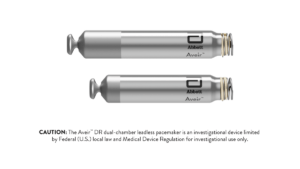 Abbott has announced that the US Food and Drug Administration (FDA) has approved the Aveir dual chamber (DR) leadless pacemaker system, described by the company as the world’s first dual chamber leadless pacing system for the treatment of abnormal heart rhythms.
Abbott has announced that the US Food and Drug Administration (FDA) has approved the Aveir dual chamber (DR) leadless pacemaker system, described by the company as the world’s first dual chamber leadless pacing system for the treatment of abnormal heart rhythms.
With more than 80% of people who need a pacemaker requiring pacing in both the right atrium and right ventricle, the approval significantly increases access to leadless pacing for millions of people across the USA, Abbott said in a press release.
”Modern medicine has been filled with technological achievements that fundamentally changed how doctors approach patient care, and now we can officially add dual chamber leadless pacing to that list of achievements,” said Vivek Y Reddy (Mount Sinai Health System, New York, USA). “In delivering a true dual chamber leadless pacemaker system, Abbott is expanding access to the benefits of leadless pacing to far more people than ever before and provided additional options to improve our ability to treat people with slow or abnormal heart rhythms.”
Aveir DR devices provide synchronised or coordinated cardiac pacing between two leadless pacemakers through Abbott’s ‘i2i’ technology, which utilises high-frequency pulses to relay messages via the naturally conductive characteristics of the body’s blood between each device.
To support dual chamber therapy, each implant communicates beat-to-beat with a paired, co-implanted device. This conductive communication uses less battery current than inductive, radio frequency or Bluetooth communication which are other alternatives used in implantable medical devices or traditional pacemakers, Abbott’s press release adds.
The US FDA approval of the Aveir DR dual chamber leadless pacemaker system comes on the heels of recent late-breaking clinical data published in The New England Journal of Medicine showing that system met its three prespecified primary endpoints for safety and efficacy. Results from the AVEIR DR i2i investigational device exemption (IDE) study through three-months post-implant showed a 98.3% implant success rate for physicians and more than 97% of people had a successful atrioventricular synchrony, so that the upper and lower chamber were beating normally, despite different types of underlying slow heart rhythms.
“Leadless pacemakers have been limited to a single chamber device because seamless, wireless synchronisation of two pacemakers has been an insurmountable engineering challenge—until now,” said Randel Woodgrift, senior vice president of Abbott’s cardiac rhythm management business. “Our team of dedicated scientists and engineers solved one of medtech’s complex challenges in treating abnormal heart rhythms with the Aveir pacemaker, a tiny device packed with powerful technology.”










